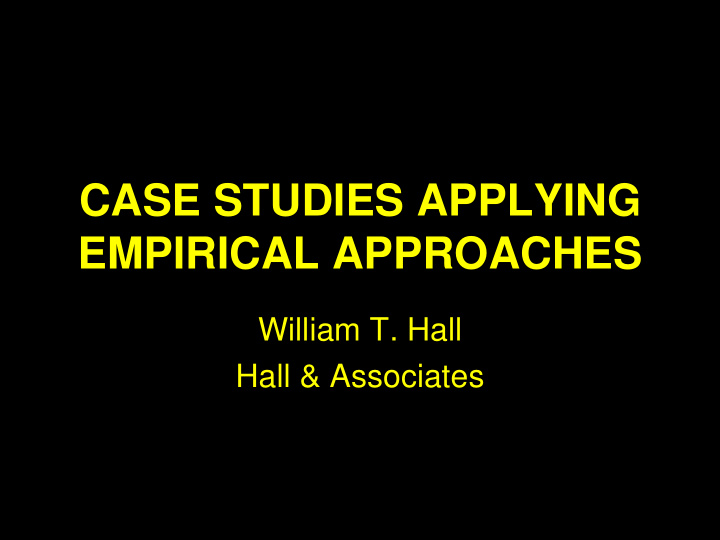



CASE STUDIES APPLYING EMPIRICAL APPROACHES William T. Hall Hall & Associates
LINEAR REGRESSION Neshaminy Creek Periphyton Data 600 Periphyton Chl-a (mg/M 2 ) Observed 500 Dodds et al. (2002) Regression TN:TP = 12:1 400 300 R 2 =0.048 200 100 0 0 0.2 0.4 0.6 0.8 1 Total Phosphorus (mg/L) Regressions based on World/Eco-Regional Data cannot predict Site-Specific responses
SITE-SPECIFIC DATA GOOSE CREEK Goose Creek/Chester Creek Periphyton Data versus TP Concentration 300 3.0 Chl-a Avg 2.5 TP Chl-a (mg/m 2 ) 200 2.0 TP (mg/L) EPA Nuisance Algae Threshold 1.5 100 1.0 0.5 0 0.0 GC-1 GC-2 GC-3 GC-4 CC-1 CC-2 CC-3 CC-4 CC-5 Station TP not causing Nuisance Periphyton Growth
CRITICAL FACTOR IGNORED Periphyton Chlorophyll-a versus Canopy Cover Wissahickon Creek Watershed, Pennsylvania 400 Chlorophyll-a (mg/m 2 ) 350 300 250 200 150 100 50 R 2 = 0.71 0 0 10 20 30 40 50 60 70 Canopy Cover (%)
CONDITIONAL PROBABILITY EPT Taxa; Change Point = 38 ug/L
CONDITIONAL PROBABILITY TP < 0.1 MG/L 20 18 16 14 EPT Taxa 12 10 Conditional Probability Plot 8 6 Change Point > 95 ug/L 4 2 1.0 0 0.9 0.001 0.01 0.1 1 0.8 TP (mg/L) 0.7 EPT Taxa < 8 0.6 Raw data scatter plot 0.5 0.4 0.3 0.2 0.1 0.0 0.001 0.01 0.1 1 TP (mg/L)
MBSS EPT DATA ANALYSIS OF VARIANCE 18 No Significant Difference; p=0.40 16 Significant; p=0.03 14 12 Avg EPT 10 8 6 4 2 0 4 - 6 7 - 8 9 - 9 10 - 10 11 - 11 12 - 12 13 - 14 15 - 16 17 - 19 20 - 24 25 - 29 30 - 39 40 - 59 61 - 97 107 - 682 Bin (TP Range - ug/L) 35 30 s n 25 io t a 20 v r e 15 s b O 10 5 0 4 - 6 7 - 8 9 - 9 10 - 10 11 - 11 12 - 12 13 - 14 15 - 16 17 - 19 20 - 24 25 - 29 30 - 39 40 - 59 61 - 97 107 - 682
CONDITIONAL PROBABILITY (Riffle Diatom TSI; Change Point = 36 ug/L)
EMAP AND NAWQA DATABASE ANALYSIS OF VARIANCE 6 5 4 Diatom TSI 3 2 RESULTS NOT SIGNIFICANT (P=0.36) 1 0 5-21 24-36.5 37-54 60-75 77-142 >150 Bin (TP Range - ug/L)
SITE-SPECIFIC EPT RESPONSE GOOSE CREEK 7 14 ortho Phosphate 6 12 Ammonia-N Nutrient (mg/L) 5 10 EPT Taxa EPT Taxa EPT Impairment Threshold 4 8 3 6 2 4 1 2 0 0 1983 1985 1987 1989 1991 1993 1995 1997 Year No TP: Invertebrate Relationship
PAXTON CREEK Paxton Creek - 2007 SRBC Data Growing Season Average 0.25 TP Impaired Sediment Impaired Segments Un-Impaired Segments Segments 0.20 Concrete TP (mg/L) Channel 0.15 0.10 0.05 TP WQS - 0.025 mg/L 0.00 1 3 2 4 5 6 7 8 9 10 11 12 HW Station Paxton Creek - 2006-2007 SRBC Data 16 No TP: 14 Sediment Impaired 12 Impairment y = 0.10x - 4.76 EPT Taxa 10 R 2 = 0.47 8 Relationship 6 Habitat Impaired Un-Impaired 4 2 0 0 20 40 60 80 100 120 140 160 180 200 Habitat Score
CONCLUSIONS • Linear Regressions inadequate – Regional data cannot be used to represent site-specific conditions – Failure to consider site-specific data yields inappropriate conclusions • Conditional Probability Analysis unreliable – Results conflict with traditional statistical evaluations – Endpoints do not reflect site-specific data; biological significance unknown
Recommend
More recommend